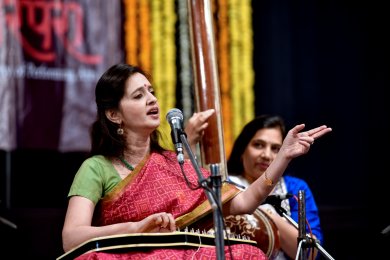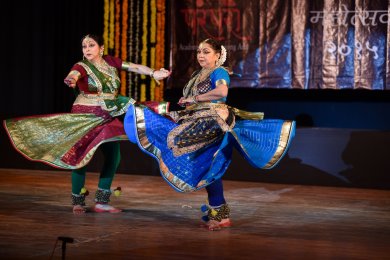
|   |

|   |
A celebration of parampara - S.D. Desai e-mail: sureshmrudula@gmail.com November 9, 2015 The mood of the evening at the one-day festival held at the Tagore Hall in Ahmedabad by Parampara Academy of Performing Arts was set by Pt Rajan-Sajan Mishra’s leading disciple Viraj Amar, an accomplished vocalist in her own right with a sizable following. Dhoondhu-n baare saiyaan... was the traditional bandish for the vilambit khayal in raag Nand she rendered pleasingly interacting with her accompanists and listeners. In the shringar-centric raag, once Hindi film music directors’ favourite, Viraj’s drut bandish was Paayal mori baaje...  Viraj Amar  Bijal Haria Bijal Haria, trained by Smita Shastri (Ahmedabad) earlier and then Sandhya Purecha (Mumbai), celebrated with this festival completion of five years of Parampara Academy, where she teaches Bharatanatyam and Kuchipudi and holds such festivals from time to time. Following a modest Bharatanatyam performance of ‘Nataraja Kauthuvam’ by her young students, with expressive ease Bijal danced a Jathiswaram that highlighted its characteristic features - supple movement in tune with the rhythmic beats and syllables beginning with taa ri jham... There is dedicated exploration in Bijal’s dance pursuits. With the central Academy’s Junior Fellowship, she has been working on the theme of angika abhinaya in Jaya Senapati’s Nrittaratnavali with special reference to Bharatanatyam and also translating the treatise into Gujarati. The young dancer is being guided in her challenging academic endeavour by Dr A.M. Upadhyay, a Sanskrit scholar, and Dr. Sandhya Purecha, a researcher, dancer and choreographer. 

Maharashtra has a strong Bhakti tradition, to which outstanding women saints as well have contributed. Dr. Purecha presented a well-choreographed three-unit Nritya Natika ‘Brahmananda’, in which she has combined nritya, natya and lokanatya on good music (recorded, as in Jathiswaram earlier). The text of the presentation holds interest with its poetic quality, modest narrative power and Bhakti rasa. All three are offerings to Lord Vitthala. Vithoba doesn’t discriminate between ‘high’ and ‘low’ - he/she who worships Him is dear to Him. Varkari saint poetess Janabai (13th c.), who has written over 300 devotional songs and is regarded as revered as Namdev, was blessed in her hut with Vithoba’s visit. Soyrabai (14th c.), Chokhemela’s wife and disciple, born a Dalit, sings of the purity of the soul. Panduranga, as the legend goes, in the guise of a Brahmin gifted her with a child. In an episode from saint poetess Venabai (16th c.), she prays to Lord Ram for the blessing of devotion for herself and mitigation of suffering from the lives of common people. In Dr. Purecha’s lively choreography of group scenes and direction of episodes supported by Manoj Desai’s engaging music, next to her performance, chiefly dramatic, it is Shanti Mohanty’s glowing benign visage as Vithoba that remains etched in memory. The four petite girls in varying choreography, each visually undistinguished from another, remained pleasing all through.  Nalini-Kamalini
This city has such an exposure to the aesthetically high form of Kathak in its elegance, grace and taste that the Banaras Gharana ‘Yugal Nritya’ presentation by Nalini-Kamalini (Guru: Jitendra Maharaj) using limited space, vocabulary and expression looked ordinary. Dr. S.D. Desai, a professor of English, has been a Performing Arts Critic for many years. Among the dance journals he has contributed to are Narthaki, Sruti, Nartanam and Attendance. He guest-edited Attendance 2013 Special Issue. His books have been published by Gujarat Sahitya Academy, Oxford University Press and Rupa. After 30 years with a national English daily, he is now a freelance art writer. |